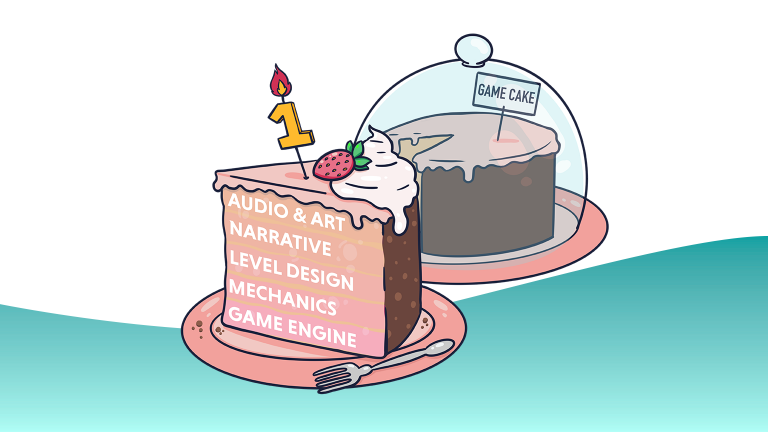Game Classification: Defining AAA, AA, and III Games
Note: this post was co-authored by Martin Mittner
At first, games were just games. Good games, bad games; big games, little games. Then came the rise of the AAA game. Suddenly a game either was or was not AAA. Inevitably, other classifications followed. In this article, we try to dig into what those are and what they mean. Along the way, we also propose some clearer and more concrete definitions for those terms than currently exist.
What Do You Mean by Game Classification?
In this context, the classification of a game refers to whether it’s recognized as a AAA, AA, III, or something else. Such classifications are informal and mostly used as marketing lingo by game creators and publishers so they can label their game as ‘better’ than others in the market. There is currently no widely recognized formal definition that decides if a game falls into one category or another. That is something we will attempt to remedy below.
AAA
This section is going to be larger than others in this article as AAA is the most widely used and well-known label applied to popular and high-profile games. It is also, arguably, one of the most divisive.
AAA (pronounced Triple-A) games are both incredibly simple and incredibly hard to define. The most basic and broadly accepted definition is, “a game with an extremely large budget.” The term AAA can be used to describe a studio or publisher as well as a game. So a AAA game is almost always made by a AAA developer and vice versa.
How large? Good question. You’re unlikely to find many people who will agree on a dollar amount that makes a game AAA, other than to say that it’s counted in the 10’s, if not the 100’s of millions. This difficulty in pinning down exactly which games are, and are not, AAA is exacerbated by the fact that most studios and publishers do not reveal their budgets. Even when they do, they rarely indicate how much was spent on development versus other factors like marketing. Add to that the fact that some creators try to falsely claim they’re making AAA games purely to get more eyes on it and the definition quickly becomes meaningless.
All of this means that determining whether a game is AAA basically comes down to a video game version of the Stewert test, i.e. “You’ll know it when you see it.”
The current definition is so imprecise that it makes discussing the subject extremely difficult. In order to try and rectify that, the Tiny Hydra team put our heads together and came up with what we believe is a better and more nuanced definition for what makes a AAA game. We have outlined those criteria, as well as why we chose them, below. But first, here is a non-exhaustive list of additional reason why the current definition of AAA is lacking, in no particular order:
- AAA implies quality but a game’s critical or commercial success is not taken into account.
- Top-end budgets have grown an order of magnitude since the term was first coined.
- The rise of games as a service (GaaS) means that budgets are not just allocated once, but instead increase over time based on a game’s success.
- The rise of mobile gaming means that a game can have the budget of a AAA but none of the other characteristics that normally distinguish a game as being AAA.
- Budget being the only qualifier means that small or less established creators have basically no way to create a AAA game, making the term elitist in a very clear and direct way.
- As the industry changes, can a game lose its AAA status? If a AAA game costs $10M to make and then 10 years later is remastered but the average cost of AAA games is now 3 times higher, is that game still AAA?
With all of that ranting out of the way, let’s look at how we can improve things. The core of our solution is to use a points-based system. Essentially, a game is required to score 7 or higher out of 10 possible points. If it scores a 5 or a 6, it is instead a AA game, Any lower than that and it’s ranked lower than AA or, as far as most people are concerned, it’s ‘just a game’. Alternatively, if a game is critically well-received and highly polished but does not meet the requirement for a AAA, it might be more appropriate to see if it qualifies as III which you can do here.
| Criteria | Score |
|---|---|
| Development and marketing budget that exceeds $25M | 2 |
| Critically well-received (e.g. 70+ on Metacritic) | 2 |
| High level of polish and low number of bugs | 2 |
| Has 20+ hours of gameplay | 1 |
| Successfully makes full use of the latest technology and/or pushes technical boundaries | 1 |
| Hyper-realistic graphics at release | 1 |
| Made by a studio that has created a previous AAA game | 1 |
The criteria are built so that a game can be reassessed at any time meaning that if bugs are eliminated or additional (free) content is released, a game can become AAA later in its lifecycle. Similarly, the opposite is true.
Let’s take a look at what some popular games score when run through this evaluation:
Example Games (Score)
- Last of Us 2 (10)
- Checks all boxes
- Hearthstone (9)
- Does not have hyper-realistic graphics
- GTA V (8)
- Was buggy on release and continues to be to a lesser extent
- Genshin Impact (8)
- No history of previous AAA titles
- No hyper-realistic graphics
- Cyberpunk 2077 (7)
- Buggy
- Attempts to push boundaries and tech but fails
As with the original definition, there is still some subjectivity to these criteria when it comes to things like: “what exactly constitutes a polished game?” But overall, there is a much higher level of both precision and nuance. We’ll be publishing a follow-up article to help clarify any ambiguity. Also, note that it is possible for both F2P and mobile games to qualify as AAA. This is intentional.
With some AAA games established, we can look at which games fail to qualify as AAA and instead fall into the AA category. But first, we should talk about the traditional definition for a AA game…
AA
The term AA (Double-A) is not as often used when talking about the quality of a game as few like to boast of being second-best. When you do find people defining this term, however, it is still most often in relation to budget. A concise traditional definition would be, “a game with a large budget but not as large as that of a AAA.”
Because this term is rarely used, you are also likely to find people who would ascribe an even less rigorous definition along the lines of, “A game which is attempting to be AAA but falls short.”
The idea of ‘not quite AAA’ is what we used as the core of our new definition which handily lets us reuse our criteria for a AAA game. Rather than having to score a 7 or more, a AA game only needs to score a 5 or a 6 to be categorized as AA. For a more in-depth description of the following criteria, read the detailed description under the heading AAA.
| Criteria | Score |
|---|---|
| Development and marketing budget that exceeds $25M | 2 |
| Critically well-received (e.g. 70+ on Metacritic) | 2 |
| High level of polish and low number of bugs | 2 |
| Has 20+ hours of gameplay | 1 |
| Successfully makes full use of the latest technology and/or pushes technical boundaries | 1 |
| Hyper-realistic graphics at release | 1 |
| Made by a studio that has created a previous AAA game | 1 |
Using our criteria, let’s look at some games that rank as AA.
Example Games (Score)
- A Plague Tale: Innocence (6)
- Budget not disclosed but unlikely to be more than $25M
- Less than 20 hours of gameplay
- Studio’s past releases do not include AAA games
- Marvel’s Avengers (6)
- Moderately well-received (67 Metacritic score)
- Lacking polish with repetitive missions
- Cities: Skylines (6)
- Budget below $25M
- Does not have hyper-realistic graphics
- Developer does not have a history of AAA games
- Aliens: Colonial Marines (5)
- Poorly received (45 Metacritic score)
- Buggy
- Does not push boundaries
- Vampyr (5)
- Low level of polish for animations and combat
- Does not push technical boundaries
- Aims for hyper-realistic graphics but falls short
As you can see, reducing the point requirement greatly increases how many games qualify while still disqualifying the vast majority of games made by small indie teams or solo developers. Note that these criteria mean that games with AAA budget which are poorly executed and received can fall into the AA score range.
III
III (pronounced Triple-I) is the newest classification to gain widespread usage, at least amongst industry professionals; many consumers are still unlikely to recognize the term. As one might guess from the name, III is meant to signify a game as being of AAA quality while still very much being an indie game (often sacrificing scope to achieve this). In other words, using the traditional definition, a AAA quality game made by a small team and with a fraction of the budget of modern AAA games.
The term arose to describe the increasing number of indie games that rival AAA games in both quality and ambition. A prime example being Hellbalde: Senua’s Sacrifice, a game with hyper-realistic graphics and excellent storytelling which was made by a core team of less than 50 people.
We have fewer issues with the traditional definition for III than for AAA as it’s based on quality, something each person can judge for themselves without having to sleuth through investment calls and press releases. However, it’s still a little imprecise, so let’s try and amend that too.
As with AAA, our criteria for III is based on a point system. In order to count as III a game needs to score 7 or more points out of a possible 10. Because III games are typically judged to have gotten as close to being a AAA game as is reasonable with fewer resources, most of the criteria are the same as our AAA evaluation with the addition that a game is also disqualified from being III if the core team making it (for the majority of the project) exceeds 50 people.
| Criteria | Score |
|---|---|
| Has a core development team of more than 50 people | Instant fail |
| Development and marketing budget that exceeds $1M | 2 |
| Critically well-received (e.g. 70+ on Metacritic) | 2 |
| High level of polish and low number of bugs | 2 |
| Has 20+ hours of gameplay | 1 |
| Successfully makes full use of the latest technology and/or pushes technical boundaries | 1 |
| Hyper-realistic graphics at release | 1 |
| Not owned or funded by a large development studio or publisher | 1 |
Examples (Score)
- Hellblade: Senua’s Sacrifice (9)
- Less than 20 hours of gameplay
- Hades (8)
- Does not push technical boundaries
- Does not have hyper-realistic graphics
- Stardew Valley (8)
- Does not push technical boundaries
- Does not have hyper-realistic graphics
- Minecraft (8)
- Does not have hyper-realistic graphics
- Owned by Microsoft
- Ori and the Blind Forest (7)
- Does not push technical boundaries
- Does not have hyper-realistic graphics
- Funded and published by Microsoft
Many games which qualify as III may also qualify as AA. Though most would consider III to be a more prestigious label than AA.
Honorable Mentions
Aside from the categories above, there are also some less well-known or more niche categories which you may hear bandied about from time to time. In the spirit of completeness, you can find them below.
AAA+
AAA+ is an obnoxious and rarely used term with two distinct (self-appointed) definitions.
The first was an early attempt to label what came to be known as games as a service. The definition was a game that was able to be monetized after release on a recurring basis. The most prominent example at the time being MMO’s which commonly operated using a subscription model.
The second and more obvious definition was a AAA game that was even more ambitious and had an even larger budget. It was a pretty shameless attempt for a small number of games to label themselves as AAA, but better.
Neither of the above definitions has yet made it into widespread usage (nor are they likely to).
AAAA
As with the second definition of AAA+, AAAA is meant to imply AAA but better. However, the definition of this term is confined specifically to next-gen games of the 9th generation of consoles (PS5, Xbox Series X/S, and equivalent PC hardware). Only time will tell if this term will make it into common parlance but our assumption would be no.
A, B, C, or D
As with AA games, you are unlikely to ever hear a studio boasting about making a B or C grade game. Because of that, the terms are rarely used but you may hear them being thrown around as an insult on occasion. Unlike AAA, which many would argue is solely decided by budget, these lower categories are usually based on quality with a B grade game being equivalent to a B-list movie.
Indie
Indie is perhaps the most commonly used label for games outside of AAA and the number of Indie games released every year far outweighs the number of AAAs. I added this to the honorable mentions because while it does often serve the same function as the others on this list (indicating the size of a games budget and/or team), it also has a whole bunch of other descriptive baggage which will take an article of its own to unpack.
Shovelware
A shovelware game is a low-budget game of poor quality with little technical or artistic merit. The term is almost exclusively used in a derogatory manner.
Do Definitions Matter?
At the end of the day, creating games is an art form and just because a game cannot be strictly defined as this or that, does not mean they are any less valuable. Many of the best games we have ever played cannot be easily labeled.
So that brings me to an important question. Are the above categories largely meaningless distinctions that have no real bearing on the enjoyment a game provides? Maybe. But, writing an article like this does at least satisfy a deep-rooted need that we and much of the industry have to quantify and categorize every single thing in the world. So there’s that!
Let us know what you think of our definitions and feel free to comment and tell us know which category your favorite game falls in.






